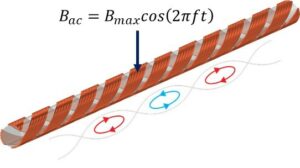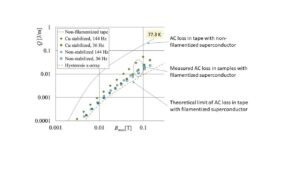Currently, superconducting conductors are commercially available, and after cooling with liquid nitrogen (temperature – 195 °C), can transmit electric currents ten times higher than classic copper conductors. Without electrical resistance, and thus without energy losses, only direct current can be transmitted.
Superconductors have this unique property due to the fact that the passing current is “pinned” by a number of microscopic current loops that try to keep it unchanged even after disconnection from the source of voltage. At the same time, this means that each change in current consumes a certain amount of energy to overcome the pinning forces. This dissipation is called alternating losses. Fortunately, we can influence the magnitude of alternating losses to a certain extent, for example by adjusting the shape of the conductor.
Very promising is the 2nd generation of high-temperature superconducting tapes, in which a thin ceramic layer with superconducting properties is applied to a metal alloy substrate and wrapped in a protective metal cover. When we investigated what limits the use of such a conductor in future accelerators, we arrived to a simple conclusion: since the AC losses, and therefore the energy costs of operation, are directly proportional to the width of the tape, it is necessary to narrow it below 50 µm. A suitable way to implement the idea is the procedure developed by the Danish company SUBRA: a layer of superconductor with a filamentary structure is created by depositing the reactants to a grooved metal substrate. A significant advantage is that compared to a standard tape without filamentary structure, the production costs remain unchanged.We manufactured several models of round conductors from the tapes produced in this way, and experimentally verified the correctness of the assumption about the reduction of alternating losses.
Gömöry, F., Solovyov, M., Šouc, J., Frolek, L., Kujovič, T., Seiler, E., Ries, R., Mošať, M., Winkler, T., Sugita, K., Dhallé, M., Krooshoop, H.J.G., Hintze, C., Troshyn, A., Prusseit, W., Nedergaard, L., Traberg, L., Christensen, J.J., Jorgensen, N.O., Bahl, C.R.H., and Wulff, A.C.: AC loss reduction in round HTS cables achieved by low-cost filamentization of tape conductors, IEEE Trans. Applied Supercond. 34 (2024) 5901605.


Currents induced in round cable from superconducting tape exposed to AC magnetic field

Tape with superconducting layer consisting of 19 filaments






